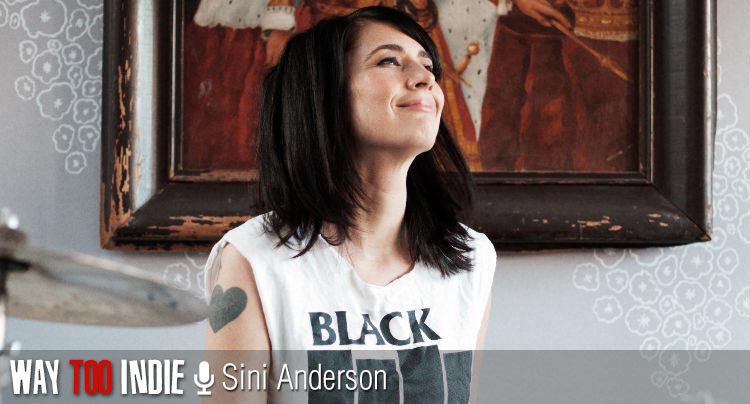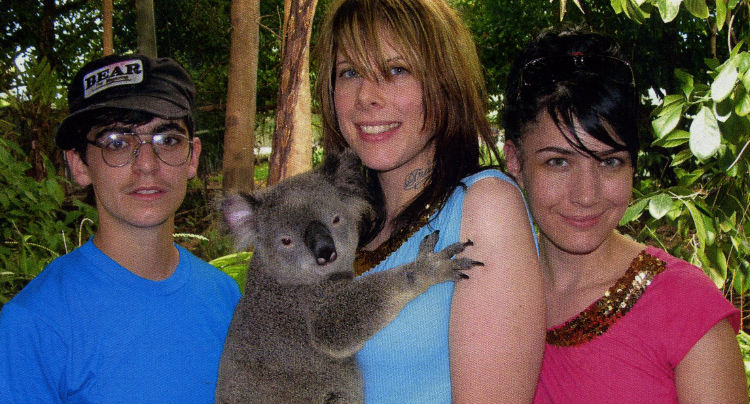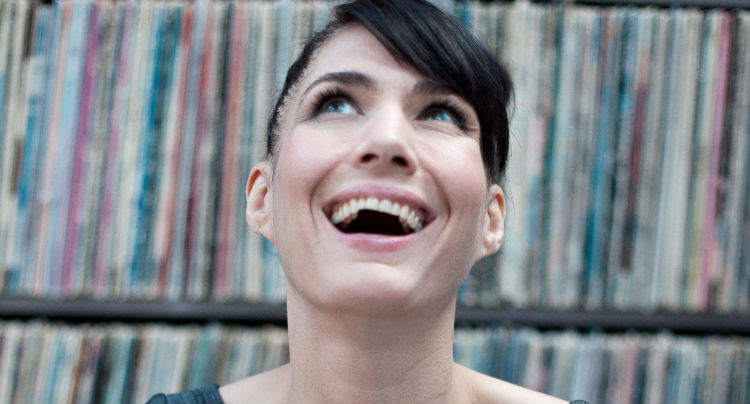Sini Anderson Talks Kathleen Hanna, Strength in Vulnerability

The Punk Singer, director Sini Anderson’s bracingly intimate portrait of her close friend, Kathleen Hanna, explores her life journey as a punk rock feminist in her early years (she was the frontwoman of both Bikini Kill and Le Tigre), writing punk zines (she’s the founder of the “riot grrrl” movement) and screaming for all the girls to come to the front of the stage at her shows, to her recent bout with Lyme disease and her disappearance from the public eye in 2005. Boasting an astounding collection of archival footage and revealing recent interviews, Anderson’s film gets to the core of what makes one of the most influential feminist figures of our time tick.
We chatted with Anderson about what makes Hanna such an important feminist figure, how she got her hands on so much archival footage, making lonely youths not feel so alone, Lyme disease striking the film’s production, and more.
The Punk Singer opens this Friday in San Francisco at the Roxie Theater. For more info visit thepunksinger.com
For our readers, maybe our female readers specifically, why do you think it’s important to know who Kathleen Hanna is?
I think that most young women could use a really strong, powerful, fashionable feminist in their lives.
Fashionable. That’s important, too.
Let’s be honest about it–a big part of why Kathleen’s feminism was able to reach so far was because she’s beautiful and she has great fashion. That’s the honest truth. She appeals to people on so many different levels, and when you get to her core message, it’s such an important message, you know what I mean? She’s also really giving permission to be political and have all this fun. It doesn’t have to be a drag and super serious all the time.
Aside from the film, how do you think people should be introduced to her work?
They should ask an older brother or sister if they have a mix tape of Bikini Kill somewhere. A Bikini Kill cassette tape.
Why this project and not the Le Tigre documentary you had planned?
I know Kathleen’s story because I’m a friend of hers. I feel really inspired by her story, and I felt like people–specifically women–really needed to hear the deeper story of who she is and where she came from, so that they could feel less alone. I think that we have a tendency–especially as women–to isolate ourselves even from our friends with parts of our lives. I think we keep our stories to ourselves. When people feel less alone, they’re more productive.
So you want this film to be a sort of companion for these girls or inspire them to do great things.
I just don’t want them to feel isolated because of the experiences they’ve had in their lives. I think that goes for young men, too. Why do they feel isolated? Because they think they’re a dork, or they’re queer…what is it that makes them feel less-than in the world? What most young people don’t know is that the ones who feel the weirdest are always the ones that end up the most successful and happy. You don’t know that when you’re young. You just feel like a freak and that no one can understand your experience. What better way than running into a story like Kathleen’s to make you feel less alone? You’re going to become more productive and the world’s going to become a better place. This is my philosophy. (laughs)

Alright! That’s amazing. I grew up in the ’90s, so the archival footage you have was absolutely amazing to me. For anyone who’s familiar punk culture at that time, you know that those guys weren’t big into filming themselves. Very anti-“selfie”.
Anti-documentation.
Right! How did you find this treasure trove of footage of Kathleen?
I didn’t find it. I got really lucky. When Kathleen said yes to the project, at that point she had already been gathering her materials for the Riot Grrrl collection at NYU. It was like winning the lottery! She and a couple of interns–all named Kate (laughs)–had been gathering all this footage from all over the place. Some people came out of the woodwork when they heard about the project. “I have a Hi-8 tape of a Bikini Kill show!” Kathleen had this footage gathered for her archive, but we didn’t know who shot it, so it’s been challenging tracking these people down. It’s cool-looking stuff.
It really is.
Here’s a fun fact: Some of the footage that’s in the film was actually shot by Corin Tucker from Sleater-Kinney before she was a musician. She did the Bikini Kill interview on the couch.
All that footage is amazing. But, it’s very rare in a documentary with a lot of archival footage like this one for the new footage to be as amazing if not more. The footage that Kathleen and Adam (Ad-Rock of the Beastie Boys, Kathleen’s husband) shot themselves in their apartment blew me away.
Here’s the thing. Kathleen is the type of person that…if she’s having a shitty, isolating experience, if she makes it public, other people will benefit from it. A lot of our friends are like that. She’s willing to show the vulnerability of her illness to potentially be of service to other people. That’s the way we operate, and it’s a good mode of operation, I think. The fact that we have been friends for a long time helped with the interviews a lot. She was more willing to let the camera go on for longer, and I was able to ask her questions that were a little bit deeper. She was really generous with her story and her time.
I was going to ask you about that. At this time, do you think you’re the only person who could have made this movie?
No. But, I think it was supposed to happen.

She trusts you so much that she divulges more sensitive information than most documentary subjects would.
There was a sense of safety, and it’s really important to feel that sense of safety when you’re offering your story. It’s a huge responsibility, also. It freaked me out.
How so?
Here’s this person that you love and respect, and you have to figure out how to put their story together.
Let’s talk about that. You have all this great archival footage and footage you shot yourself. Talk about shaping the story in the editing room.
It went in a lot of different directions. Tamra Davis was the finishing producer who came on, and she really pushed it through to the end with our editor, Bo Mehrad. That, for the most part, was whipping all of that archival footage into shape. The other parts of Kathleen’s story–the danger she was in while she was in Bikini Kill, the illness–these things were really developed, but we were out of money, out of space, and dead in the water. I went to Tamra and said, “please!” She moved the edit into our house and sat with our editor and really took it to the end. I feel really lucky in that aspect.
The story shifted throughout making it several times. When we stared, I was like, “I know Kathleen’s story. I’m her friend, and I know exactly how I want to tell it.” Three months later, I was like, “I have no idea how I’m going to tell this.” Then, she was diagnosed with Lyme disease halfway through the production.
You’re kidding! So that happened during filming?
It changed everything. When she was diagnosed, I was like, “Oh, it’s Lyme disease. No big deal!” I thought she’d get over it really quickly. How bad could it be? Then, I ended up in the hospital with Lyme disease during the shooting. I was completely floored with the illness, and I saw her story in a completely different way. We both kind of picked up the pieces to finish the film. We were in treatment for a long time.
Does that fall in line with what you said earlier, about how the project was meant to be?
It sounds like a bad senior thesis. “You and your subject both have Lyme disease!” It’s an illness that people don’t think exists. It’s perfect for the film; you couldn’t make this shit up. So yeah, I felt like it was supposed to happen. it was very clear.
How important is it that the film is coming out now.
I think it’s the perfect time for it to come out. During the main year of production, feminism was in a real lull. When we started the process, there wasn’t a lot of activism going on at all. Within that year, the Pussy Riot stuff happened, the Sandra Fluke stuff happened, the Slutwalk in Toronto happened…all of these feminist things were popping up all over the place, and I was like, “Right. Perfect!” Now is the time to try to really invigorate the next wave of feminism. I think that more artists need profiles done about them mid-career. We don’t need to wait until they’re not here anymore, you know? It gives the rest of us energy to see their work, and it can also re-inspire the artist to continue to make their work. I’m a big fan of having the story not be the final story. This doesn’t have to be the last documentary about Kathleen.
When people think about feminism, they think about these strong, tough women who demand to be heard. Kathleen does exhibit strength in the film, but she exhibits it through vulnerability, leaving it all out there for us to see. Is vulnerability an important part of feminism?
Yeah, it is. It depends on where it’s coming from and who’s exhibiting it. Vulnerability, when you’re not completely grounded and safe, is not what you want to be going for. It can really, really work against you, especially as a woman. When you’re in a place where you’re a little bit more resolved, you have a good idea of what you’re dealing with with your personal issues, and you’re able to go out and be vulnerable and emote and still be okay, and the viewer doesn’t feel like they have to take care of you, that’s when it’s really powerful. That’s what Kathleen did here. We all know that she’s a complete ass-kicker and that she’s going to take care of herself, and she’s saying, “this is how hard it actually is, and I’m okay.” That invigorates other young women.
It’s really easy to think that everybody’s life is so great when you look on Facebook. People look at my Facebook page and go, “Yeah! Your life is so amazing right now!” and it’s like, “It’s Facebook, dude!” Life is hard for everybody. When we can see those parts that are difficult and see that the person is okay and made it through that, it gives us energy to get through our shit.
